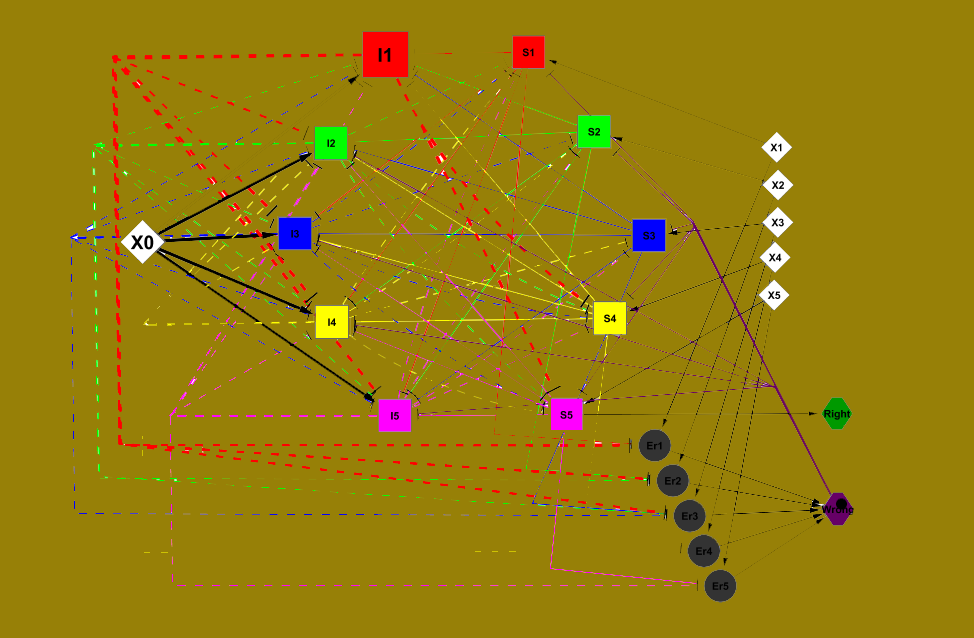Team:Sweden/Mathematical Modelling
From 2009.igem.org
(→The Linguistic Cell) |
(→The Linguistic Cell) |
||
| Line 35: | Line 35: | ||
<font color="blue">In this section you will find everything about the modeling of the sentence parsing cell. | <font color="blue">In this section you will find everything about the modeling of the sentence parsing cell. | ||
| - | + | ==Design obstacles and Solutions== | |
Several problems needed to be taken care of when implementing a biological model. | Several problems needed to be taken care of when implementing a biological model. | ||
| - | + | :* Repeated input (e.g. det det adj) | |
| - | + | :* Wrong input (e.g. det adj det) | |
| - | + | ||
For the repeatedly inputting the same PoS we used a counter (with courtesy of ETH iGEM 2005) which counts how many times an input occurs in a row. It uses an interval state and an intermediate input to move the automaton from one state to the other. | For the repeatedly inputting the same PoS we used a counter (with courtesy of ETH iGEM 2005) which counts how many times an input occurs in a row. It uses an interval state and an intermediate input to move the automaton from one state to the other. | ||
For the wrong input we set inhibitions in the model in a specific way. | For the wrong input we set inhibitions in the model in a specific way. | ||
| - | + | ==The theory== | |
| - | + | ||
Several assumptions have been made to make the model work the way we want it to. | Several assumptions have been made to make the model work the way we want it to. | ||
| - | + | :* I1 is always active at t=0, meaning that every sentence begins with and intermediate input to activated I1. | |
| - | + | :* The strength of every inhibition is the same | |
| - | + | :* We introduce a stop signal, so we know when a sentence is finished | |
| - | + | ||
| - | + | ||
| - | + | ||
We used ODEs to model the system. In general, it the ODEs look like this: | We used ODEs to model the system. In general, it the ODEs look like this: | ||
| Line 61: | Line 56: | ||
State i = synthesis * (every incoming activation and repression) – degradation of i | State i = synthesis * (every incoming activation and repression) – degradation of i | ||
| - | :<math>\text{dydt}_i = syn_i \prod \limits_{j\in i} \begin{cases} act_j, & \text{if } j \text{ activates } i \\ rep_j, & \text{if } j \text{ inhibits } i \end{cases} - \text{deg}_i</math> | + | :<math> \text{dydt}_i = syn_i \prod \limits_{j\in i} \begin{cases} act_j, & \text{if } j \text{ activates } i \\ rep_j, & \text{if } j \text{ inhibits } i \end{cases} - \text{deg}_i </math> |
| + | |||
| + | For activation and repression we used a hill function: | ||
| + | |||
| + | act = ((conc*k)^m)/(1+(conc*k)^m), | ||
| + | |||
| + | where k is the responsible for when the activation occurs and m for how fast it is. The repression is simply | ||
| + | |||
| + | rep = 1 – act | ||
| + | This way we set up a model as in the figure. This model does not represent the full automaton, but only the first four states. | ||
| - | + | </font> | |
Revision as of 07:39, 19 October 2009
| Home | Team | Project | Mathematical Modelling | Logbook | Result | Sponsors |
|---|
The Linguistic Cell
In this section you will find everything about the modeling of the sentence parsing cell.
Design obstacles and Solutions
Several problems needed to be taken care of when implementing a biological model.
- Repeated input (e.g. det det adj)
- Wrong input (e.g. det adj det)
For the repeatedly inputting the same PoS we used a counter (with courtesy of ETH iGEM 2005) which counts how many times an input occurs in a row. It uses an interval state and an intermediate input to move the automaton from one state to the other. For the wrong input we set inhibitions in the model in a specific way.
The theory
Several assumptions have been made to make the model work the way we want it to.
- I1 is always active at t=0, meaning that every sentence begins with and intermediate input to activated I1.
- The strength of every inhibition is the same
- We introduce a stop signal, so we know when a sentence is finished
We used ODEs to model the system. In general, it the ODEs look like this:
State i = synthesis * (every incoming activation and repression) – degradation of i
- <math> \text{dydt}_i = syn_i \prod \limits_{j\in i} \begin{cases} act_j, & \text{if } j \text{ activates } i \\ rep_j, & \text{if } j \text{ inhibits } i \end{cases} - \text{deg}_i </math>
For activation and repression we used a hill function:
act = ((conc*k)^m)/(1+(conc*k)^m),
where k is the responsible for when the activation occurs and m for how fast it is. The repression is simply
rep = 1 – act
This way we set up a model as in the figure. This model does not represent the full automaton, but only the first four states.
 "
"

